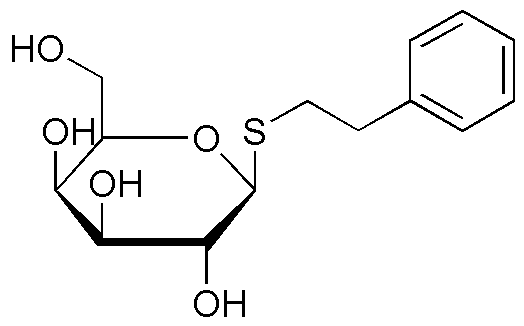2-Phenylethyl-b-D-thiogalactoside is widely utilized in research focused on:
- Biochemical Research: This compound serves as a substrate for studying galactoside metabolism, helping researchers understand enzyme activity and carbohydrate interactions.
- Drug Development: Its unique structure makes it valuable in developing new pharmaceuticals, particularly in targeting specific biological pathways related to glycosylation.
- Cell Biology: It is used to investigate cell signaling and receptor interactions, providing insights into cellular responses and potential therapeutic targets.
- Microbiology: This chemical aids in differentiating bacterial strains based on their ability to metabolize galactosides, which is crucial for identifying pathogens.
- Food Science: It can be applied in studying the fermentation processes of dairy products, enhancing flavor profiles and improving product quality.
General Information
Properties
Safety and Regulations
Applications
2-Phenylethyl-b-D-thiogalactoside is widely utilized in research focused on:
- Biochemical Research: This compound serves as a substrate for studying galactoside metabolism, helping researchers understand enzyme activity and carbohydrate interactions.
- Drug Development: Its unique structure makes it valuable in developing new pharmaceuticals, particularly in targeting specific biological pathways related to glycosylation.
- Cell Biology: It is used to investigate cell signaling and receptor interactions, providing insights into cellular responses and potential therapeutic targets.
- Microbiology: This chemical aids in differentiating bacterial strains based on their ability to metabolize galactosides, which is crucial for identifying pathogens.
- Food Science: It can be applied in studying the fermentation processes of dairy products, enhancing flavor profiles and improving product quality.
Documents
Safety Data Sheets (SDS)
The SDS provides comprehensive safety information on handling, storage, and disposal of the product.
Product Specification (PS)
The PS provides a comprehensive breakdown of the product’s properties, including chemical composition, physical state, purity, and storage requirements. It also details acceptable quality ranges and the product's intended applications.
Certificates of Analysis (COA)
Search for Certificates of Analysis (COA) by entering the products Lot Number. Lot and Batch Numbers can be found on a product’s label following the words ‘Lot’ or ‘Batch’.
*Catalog Number
*Lot Number
Certificates Of Origin (COO)
This COO confirms the country where the product was manufactured, and also details the materials and components used in it and whether it is derived from natural, synthetic, or other specific sources. This certificate may be required for customs, trade, and regulatory compliance.
*Catalog Number
*Lot Number
Safety Data Sheets (SDS)
The SDS provides comprehensive safety information on handling, storage, and disposal of the product.
DownloadProduct Specification (PS)
The PS provides a comprehensive breakdown of the product’s properties, including chemical composition, physical state, purity, and storage requirements. It also details acceptable quality ranges and the product's intended applications.
DownloadCertificates of Analysis (COA)
Search for Certificates of Analysis (COA) by entering the products Lot Number. Lot and Batch Numbers can be found on a product’s label following the words ‘Lot’ or ‘Batch’.
*Catalog Number
*Lot Number
Certificates Of Origin (COO)
This COO confirms the country where the product was manufactured, and also details the materials and components used in it and whether it is derived from natural, synthetic, or other specific sources. This certificate may be required for customs, trade, and regulatory compliance.


